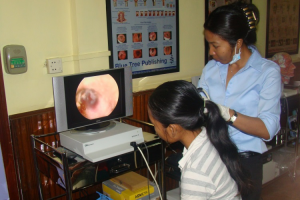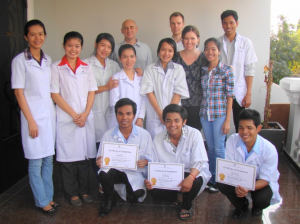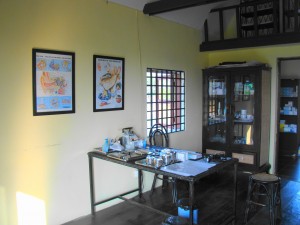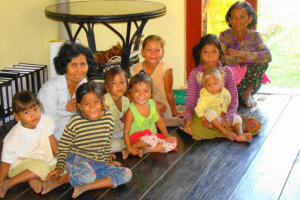All Ears Cambodia was started by Glyn Vaughan, a senior audiologist at Charing Cross Hospital, in 2003, and provides a unique medical service in a country torn by years of war. It works with all Cambodians from new-borns to the elderly, and from all walks of life. These include children and adults from some of the poorest families in Cambodia, internal refugees, physically disabled and profoundly deaf children, street children, drug addicts, landmine victims and victims of domestic violence, trafficking and prostitution.
After thirty years of civil war, Cambodia remains one of the poorest, most disease- racked nations on earth. During the genocidal regime of the Khmer Rouge, health services were all but destroyed, and over 90% of Cambodian doctors were executed, died or left the country. Today ear disease in Cambodia receives little or no attention and All Ears Cambodia provides the vital support that those with ear problems need.
Hearing is fundamental. It connects us with the world. It is the very means by which we develop speech and language to communicate our thoughts and ideas. Its loss is one of the most severe and least recognised disabilities, yet so rife it affects a quarter of a billion people on earth. The damage it causes can be life-shattering. Over half of the Cambodians afflicted are children, most of them living in abject poverty. A great number of these cases could have been prevented, and in some villages, chronic ear disease in Khmer children is so common, it is considered normal. Of the ones in need of hearing aids less than 1% has them. The cost of a modern digital hearing aid is more than a Cambodian peasant would pay for his house. All Ears Cambodia strives to reach out and help these people.
From its humble beginnings All Ears Cambodia now has three clinics operating in Phnom Penh, Siem Reap and Kratie. They offer primary health care, diagnostic and rehabilitative audiology services, ear- mould making, hearing aid repairs, and health education. Health education is essential, and in rural Cambodia it is often the most basic education in ear health care that brings about the most significant change. Ignorance and poverty lead families to look to old superstitions. Troubled ears are jabbed with chicken quills, have petrol poured inside them, or are packed with the entrails of dead animals.
Access to specialist care remains a critical problem. 85% of Khmers live in rural areas. Most live simple lives in scattered villages and infrastructure is poor. Transport for many is unaffordable. To address this All Ears operate outreach clinics in Prey Tralach, Kep, Kampot, Kandal, Sihanoukville, Pursat and Kampong Chhnang. They also run a clinic at the Kein Khleang Leprosy Unit.
MSAVLC have proudly supported Ears Cambodia for many years by providing medical equipment for its clinics and more recently sponsoring the training of some of its staff. Trustees have visited Glyn Vaughan and his staff on many occasions and as well as attending clinics in Phnom Penh and Siem Reap they have accompanied audiologists on their visits to the Leprosy Clinic and to the outreach clinic in Prey Tralach. All of these visits have made us aware of the vital importance of the work of All Ears Cambodia, and to experience for ourselves some of the difficulties that have to be overcome to partake in this work.
OUTREACH VISIT TO PREY TRALACH
“During our visit to Phnom Penh, we were invited to accompany two clinicians from All Ears Cambodia to an outreach clinic in Prey Tralach, a small village, deep in the countryside and well off the beaten track. We had been warned that the village was difficult to reach and very basic, and that the noise of bugs was a problem with mosquitos and other ‘winged creatures’ flocking to the light! We were told to take torches as there would be no electricity at night, and that the area had been the last stronghold of the Khmer Rouge! It certainly made us think, but we were determined to go! We set off next day, in a 4×4 with Seyha and Ruth (Root), a little apprehensive, for the 300 kilometre journey. We drove through dusty streets full of traffic, with vans crammed with people and goods, some folk sat on top of the load and others clinging to the sides! Women and children had baskets on their heads containing snails which they had collected from the river. The road degenerated as we progressed, and was full of potholes making driving difficult. There were ox-carts on the roads, and cows roamed willy-nilly out in front of the traffic. After about five hours we turned off onto a dirt road, very uneven in places and with drainage ditches on each side. The lorry in front of us was kicking up red dust, making vision impossible and stones were chipping up at the doors and windows. There were shacks along the roadside and bare-footed children in ragged clothes. Dry rice fields were on either side. Large trucks loaded with logs to be chopped for firewood passed us by, with difficulty. Muddy pools were being fished by local women. Eventually we turned off onto what can only be described as a dirt track, which made the previous road seem almost perfect! We drove along this for about an hour, bumping along amid huge craters and gulleys, swerving precariously from one side to the other, at a snail’s pace and tossed up and down inside the car. Suddenly we reached a dead-end, as a small stone wall had been constructed blocking us off, and we had to deviate across a field before regaining the track. We wondered where on earth we were going, but eventually we reached the clinic, a surprisingly well-built wooden building, and well stocked with audiology equipment and medicines. Ruth took us on a tour of their neighbours, who lived in huts scattered nearby. They were very, very poor, their houses made of wood and thatch, and in great disrepair. There had been no rain there for a year now and the land was barren and dry. A few thin cows and chickens roamed around. The men were trying to make a living chopping wood and putting it into kilns to burn for charcoal. Some men had been in trouble with the police for cutting down trees from the forests. The stench from the charcoal burning was quite overpowering. One lady was chewing beetle nuts, her mouth dripping from the red dye; it is supposed to strengthen the teeth. She called us over and gave us a present of a bunch of bananas picked from one of the few mature trees. We did not want to take them from someone so poor, but were told to do so, as she would be offended if we did not.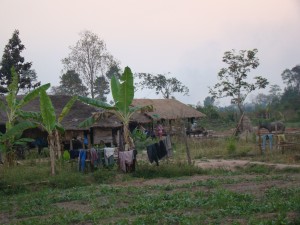
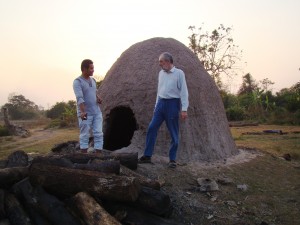 We returned to the clinic as night was falling and we slept on rather lumpy bed-rolls under our mosquito net, but had to brush out the insects inside the net before settling down. It was absolutely pitch-black and very hot. For some reason, I felt a little scared. There were unfamiliar sounds outside, crickets, geckos calling, dogs barking and owls hooting. I waited in apprehension for the winged creatures that we had been warned about, but fell asleep at last. The stars were the size of saucers in the black sky. I have never before experienced such darkness and such stillness.
Awoke at about 6 a.m. to a beautiful day, the net had worked and we were not bitten. Had a cold shower, feeling very privileged to do so, as we are one of the few houses to possess a well. It was only later that Peter admitted to me that we had shared our bed with a very large spider!
We set off early along a pitted track to a school about an hour away, where Seyha and Ruth were to hold an audiology session. On arrival we were surrounded by what seemed like all of the school’s 1,200 children, who were fascinated by us. The children were all from poor families and wore grubby ill-assorted clothes, but big smiles! Seyha and Ruth set up their make-shift clinic in one of the classrooms, and started work, examining ears and noses, testing hearing and treating ailments with various medicines. A lady from the People’s Committee was there to help, and apart from the school children, several villagers called in for treatment also. Children peered in the window to watch and others sat in the classrooms, waiting their turn. Pete sat by the door attempting to control admission and shooing them away with a broom! Seyha and Ruth worked tirelessly throughout the morning and between them they saw 33 patients. We had a snack lunch and continued work at about 1 p.m. This started off as before with children being examined and treated, but soon became minor chaos with mums arriving for treatment themselves, leaving the children to run wild. The clinic finished about 4.15 p.m. They had seen 51 more patients, 84 in all! There are fifteen schools in five communes near Prey Tralach, and All Ears visit each once a month.
We returned to the clinic as night was falling and we slept on rather lumpy bed-rolls under our mosquito net, but had to brush out the insects inside the net before settling down. It was absolutely pitch-black and very hot. For some reason, I felt a little scared. There were unfamiliar sounds outside, crickets, geckos calling, dogs barking and owls hooting. I waited in apprehension for the winged creatures that we had been warned about, but fell asleep at last. The stars were the size of saucers in the black sky. I have never before experienced such darkness and such stillness.
Awoke at about 6 a.m. to a beautiful day, the net had worked and we were not bitten. Had a cold shower, feeling very privileged to do so, as we are one of the few houses to possess a well. It was only later that Peter admitted to me that we had shared our bed with a very large spider!
We set off early along a pitted track to a school about an hour away, where Seyha and Ruth were to hold an audiology session. On arrival we were surrounded by what seemed like all of the school’s 1,200 children, who were fascinated by us. The children were all from poor families and wore grubby ill-assorted clothes, but big smiles! Seyha and Ruth set up their make-shift clinic in one of the classrooms, and started work, examining ears and noses, testing hearing and treating ailments with various medicines. A lady from the People’s Committee was there to help, and apart from the school children, several villagers called in for treatment also. Children peered in the window to watch and others sat in the classrooms, waiting their turn. Pete sat by the door attempting to control admission and shooing them away with a broom! Seyha and Ruth worked tirelessly throughout the morning and between them they saw 33 patients. We had a snack lunch and continued work at about 1 p.m. This started off as before with children being examined and treated, but soon became minor chaos with mums arriving for treatment themselves, leaving the children to run wild. The clinic finished about 4.15 p.m. They had seen 51 more patients, 84 in all! There are fifteen schools in five communes near Prey Tralach, and All Ears visit each once a month.
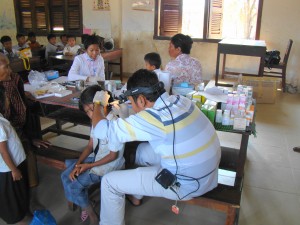
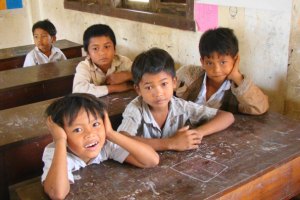 We drove back passing the dilapidated shacks on the way. It’s all very well to see the poverty, but to live for a short while amongst it, albeit in relative comfort, is an amazingly humbling experience. The people here really have so little, almost nothing. We killed the insects inside the mosquito net before settling down for our second night!
We awoke early to the sound of cocks crowing, dogs barking, and birds singing! Also the rather stifling smell of the wood smoke, but it was a wonderful morning with a beautiful sunrise. Cows were grazing quietly by the trees; it was very peaceful, the beauty hiding the poverty for a while.
There was a clinic in the morning, and some people had walked from miles around to attend. One old lady arrived with her seven grandchildren. Their parents were away working in Thailand. All seven apparently had ear problems and grandma too! One young man arrived in obvious distress, with a cockroach in his ear, which was eventually removed. All the patients waiting to be seen were sat on the floor, watching the show in amusement, oblivious to the poor man’s suffering, which thankfully was relieved. Ruth gave them a running commentary! Eighteen patients were seen that morning.
The service provided by All Ears is invaluable to this poor community where no other help is available, and it was given in a kind and professional manner.
Later we set off on the bumpy road back to Phnom Penh, it certainly had been an incredible experience, for us, but our hearts went out to those we left behind!”
We hope that with your donations, MSAVLC will be able to continue funding outreach clinics such as these, in future years.
We drove back passing the dilapidated shacks on the way. It’s all very well to see the poverty, but to live for a short while amongst it, albeit in relative comfort, is an amazingly humbling experience. The people here really have so little, almost nothing. We killed the insects inside the mosquito net before settling down for our second night!
We awoke early to the sound of cocks crowing, dogs barking, and birds singing! Also the rather stifling smell of the wood smoke, but it was a wonderful morning with a beautiful sunrise. Cows were grazing quietly by the trees; it was very peaceful, the beauty hiding the poverty for a while.
There was a clinic in the morning, and some people had walked from miles around to attend. One old lady arrived with her seven grandchildren. Their parents were away working in Thailand. All seven apparently had ear problems and grandma too! One young man arrived in obvious distress, with a cockroach in his ear, which was eventually removed. All the patients waiting to be seen were sat on the floor, watching the show in amusement, oblivious to the poor man’s suffering, which thankfully was relieved. Ruth gave them a running commentary! Eighteen patients were seen that morning.
The service provided by All Ears is invaluable to this poor community where no other help is available, and it was given in a kind and professional manner.
Later we set off on the bumpy road back to Phnom Penh, it certainly had been an incredible experience, for us, but our hearts went out to those we left behind!”
We hope that with your donations, MSAVLC will be able to continue funding outreach clinics such as these, in future years.
KIEN KLIENG LEPROSY REHABILITATION CENTRE
“In February Peter and I accompanied Sin Tith Makara, an Audiologist and Primary Health Care Clinician from All Ears Cambodia, and Koy Bopha, an Audiology Trainee, to the Kien Klieng Leprosy Rehabilitation centre in Phnom Penh. We were shown around the centre by Bean Sithan, the Social, Economic and Rehabilitation Co-ordinator, and his colleague Mr. Lang Sophea, who had himself suffered with leprosy. The centre was doing a marvellous job; by education and public awareness the number of new cases of leprosy in Cambodia had dropped from 3,000 in 1997 to 317 in 2012. The centre comprised of a hospital ward accommodating 50 patients, a treatment room, an activities room, a canteen, a physiotherapy room, an education room, a laundry and a kitchen. As well as treating leprosy sufferers, the centre was aiming to educate the public about the myths and misconceptions which surround the disease. Although leprosy can now be successfully treated with multi-drug therapy, people with leprosy continue to face social discrimination even after they are cured. Whole families are marginalized, sometimes with devastating results. Leprosy is an infectious disease caused by a bacterium called Mycobacterium Leprae. It is probably spread from tiny droplets in the nose. It usually affects the skin and nerves. Skin lesions have decreased sensation and nerve damage, which result in disability, painful nerves, and weakness of muscles. The loss of sensation means people cannot feel pain and can sustain injuries or burns, resulting in wounds and ulcers. The weakness of muscles can lead to clawing of the hands, drop foot and inability to close the eyes. However, leprosy can be cured with six to twelve months of Multiple Drug Therapy, and within 24-48 hours of starting the medicine, the patient is no longer contagious. Patients can stay at the centre whilst their skin conditions are being treated, as their ulcers can be very severe. It is estimated that if a patient has lesions in up to five places this will take six months to heal, and more than five will take at least year. Patients also stay for physiotherapy, and pre-operative and post-operative care for reconstruction surgery. The centre has three support workers who are themselves leprosy victims. All the patients are given vocational training, or retraining for work if their disabilities demand it. They are taught how to use false hands and to hold pens, toothbrushes and spoons with them. Sunglasses are supplied to protect the eyes from the sun and dust, if their eyelids do not close. Special soft shoes are supplied to protect the feet. Outreach care is given to patients when they leave the centre if required, and the centre try to teach self-care, and encourage sufferers to set up businesses, or return to school. Leaflets were available for public education One of the support workers, Mr. Lang Sophea was a monk when he was diagnosed, and he told us a little of his story. It took ages for the condition to be recognised and he was treated wrongly with Khmer medicines during that time. He had also experienced a great deal of discrimination and made to feel ‘unclean’. He felt that he now wanted to help other sufferers. Due to the nerve damage and impaired immune system, hearing can often be affected, and All Ears hold a clinic at the centre once a month. We attended the clinic which was very efficiently run and 24 patients were seen, ear infections were treated, hearing tests done, and measurements taken for hearing aids if necessary. Treatment was free, as is all treatment at this centre. A Spanish charity supports the centre at the moment, but due to the economic situation, they are expected to withdraw next year. The centre will then find it very difficult to continue, if more help is not found. It costs about $120,000 USD a year to run, and only a very small amount is given by the government. We were privileged to be able to meet the patients, some of whom had severe disabilities, and were awaiting reconstruction surgery. We were very impressed with the clinic and the care and kindness that was given to the sufferers. It will be a disaster if it has to close!”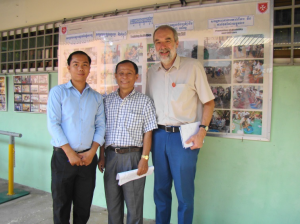
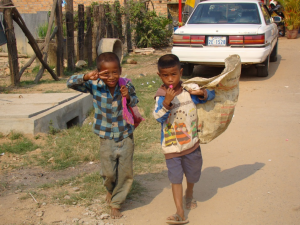
2015
All Ears Cambodia were visited by the Trustees again in 2015. The director Glyn Vaughan informed them that All Ears had now expanded its services and had done some work in Bhutan and North Korea. There was also the likelihood that he would be doing some assessment work in Vientiane, Laos.
Our two sponsored students, Pearum and Veasna had graduated with flying colours, and were now working as clinicians at the clinic in Phnom Penh and at outreach clinics in Siem Reap, Prey Tralach and Kratie. The two year training course had been very successful and six of the students had now graduated, thereby bolstering up the skilled AEC workforce.
Glyn was implementing a Continuing Professional Development plan and he had been helped with this by Dr. Simon Browning, ENT consultant at the University of Wales, by a visit from a group of specialist doctors from Singapore, and by Charlie Huins, a surgeon from the Ear Nose and Throat Hospital in London.
MSAVLC agreed to sponsor a New Recruits Project which will start in October 2015.
We are very sad to report that San Pearum passed away in July 2015. Our sincere condolences go to his family and all his colleagues and friends at All Ears Cambodia.
2019
Since 2015 MSAVLC has funded student training over a two-year period, and reports of the student’s progress has been regularly received. All students graduated successfully.
At present MSAVLC is funding a new project, LISTEN.OUT.LOUD Kratie! which provides primary ear health care, health education and aural rehabilitation of disabling hearing loss in children and adults, in eastern Cambodia. Regular updates on the project have been received, and the project will run until February 2020.
2020 – UPDATE
Due to the Covid 19 pandemic, Trustees were not able to visit All Ears Cambodia this year as planned.
The Listen.Out.Loud. Kratie! Project has proved very satisfactory reaching out to over 20,000 people during its implementation, and the Trustees agreed to sponsor this project for a further year and assess again at the end of this time.
Five binocular headlights were purchased for All Ears Cambodia. These headlights are used for ontological examination and treatment of infectious diseases and anomalies of the outer and middle ear. The headlights were employed in multiple sites in Siem Reap, Battambang and other outreach clinics.
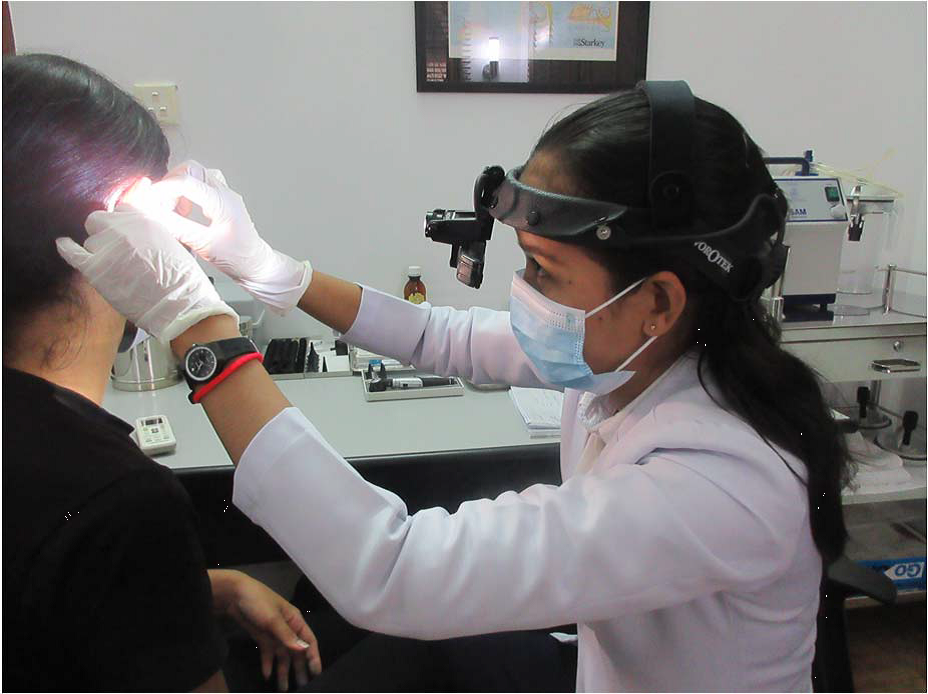
2023 – UPDATE
In March, Trustees from MSAVLC were able to visit All Ears Cambodia which is based in Phnom Penh. Here we were met by our friend of many years, the Founder/Director, Glyn Vaughan, who gave us comprehensive tours of both All Ears’ sites. The clinics were well run, by a number of very able clinicians who worked with high quality equipment in clean and pleasant premises. We met with staff and patients and were able to check All Ears Cambodia’s meticulously-kept accounts, to see how monies donated by MSAVLC donors had been spent. Glyn has built a strong organisation, serving not only Phnom Penh and its surrounding area, but with clinics in Siem Reap, Prey Tralach, and Kratie.
Later we sat in on the “Listen.Out.Loud” Project which we helped fund. It teaches children about the ear and ear care with the aid of some BBC videos, musical instruments and games. They were using the musical instruments which MSAVLC had bought, including guitars, glockenspiel, tambourine, ukulele, tabla drums, xylophone and maracas. We were also able to watch ear moulds being manufactured.
MSAVLC has also funded a doctor to work at the clinics, and we were able to meet him and discuss his work at All Ears.
A few days later, the Trustees visited the All Ears Clinic in Siem Reap. This clinic is run on the same lines as the clinics in Phnom Penh, with a mixture of private and non-fee-paying patients being treated. The money from the fee-paying patients goes towards the treatment of the poor, street kids, HIV children, NGO referrals and the underprivileged.
It is from this clinic that, twice a month, clinicians visit local primary schools to check the children’s ears and present the “Listen.Out.Loud” Show.
We were impressed by the work of All Ears, and hope to continue supporting them in the future.





Trustees with the Director and Staff at All Ears Cambodia.
The Listen.Out.Loud Show.
Making ear moulds.m


















